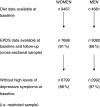Dietary patterns and depressive symptoms in a UK cohort of men and women: a longitudinal study
- PMID: 28918774
- PMCID: PMC5848748
- DOI: 10.1017/S1368980017002324
Dietary patterns and depressive symptoms in a UK cohort of men and women: a longitudinal study
Abstract
Objective: There is evidence to suggest that individual components of dietary intake are associated with depressive symptoms. Studying the whole diet, through dietary patterns, has become popular as a way of overcoming intercorrelations between individual dietary components; however, there are conflicting results regarding associations between dietary patterns and depressive symptoms. We examined the associations between dietary patterns extracted using principal component analysis and depressive symptoms, taking account of potential temporal relationships.
Design: Depressive symptoms in parents were assessed using the Edinburgh Postnatal Depression Scale (EPDS) when the study child was 3 and 5 years of age. Scores >12 were considered indicative of the presence of clinical depressive symptoms. Diet was assessed via FFQ when the study child was 4 years of age.
Setting: Longitudinal population-based birth cohort.
Subjects: Mothers and fathers taking part in the Avon Longitudinal Study of Parents and Children when their study child was 3-5 years old.
Results: Unadjusted results suggested that increased scores on the 'processed' and 'vegetarian' patterns in women and the 'semi-vegetarian' pattern in men were associated with having EPDS scores ≥13. However, after adjustment for confounders all results were attenuated. This was the case for all those with available data and when considering a sub-sample who were 'disease free' at baseline.
Conclusions: We found no association between dietary patterns and depressive symptoms after taking account of potential confounding factors and the potential temporal relationship between them. This suggests that previous studies reporting positive associations may have suffered from reverse causality and/or residual confounding.
Keywords: ALSPAC; Depression; Dietary patterns; Edinburgh Postnatal Depression Scale; Principal components analysis.
Figures
Similar articles
-
Dietary patterns in UK adolescents obtained from a dual-source FFQ and their associations with socio-economic position, nutrient intake and modes of eating.Public Health Nutr. 2014 Jul;17(7):1476-85. doi: 10.1017/S1368980013001547. Epub 2013 Jun 20. Public Health Nutr. 2014. PMID: 23782861 Free PMC article.
-
Vegetarian diets and depressive symptoms among men.J Affect Disord. 2018 Jan 1;225:13-17. doi: 10.1016/j.jad.2017.07.051. Epub 2017 Jul 28. J Affect Disord. 2018. PMID: 28777971
-
Dietary patterns of men in ALSPAC: associations with socio-demographic and lifestyle characteristics, nutrient intake and comparison with women's dietary patterns.Eur J Clin Nutr. 2010 Sep;64(9):978-86. doi: 10.1038/ejcn.2010.102. Epub 2010 Jun 23. Eur J Clin Nutr. 2010. PMID: 20571501
-
Depression in men in the postnatal period and later child psychopathology: a population cohort study.J Am Acad Child Adolesc Psychiatry. 2008 Apr;47(4):390-398. doi: 10.1097/CHI.0b013e31816429c2. J Am Acad Child Adolesc Psychiatry. 2008. PMID: 18388761 Free PMC article. Review.
-
A longitudinal study of Latino and non-Hispanic mothers' and fathers' depressive symptoms and its association with parent-child communication.J Affect Disord. 2018 Feb;227:580-587. doi: 10.1016/j.jad.2017.10.046. Epub 2017 Oct 31. J Affect Disord. 2018. PMID: 29172050 Free PMC article. Review.
Cited by
-
Fruit and vegetable consumption is associated with improved mental and cognitive health in older adults from non-Western developing countries.Public Health Nutr. 2019 Mar;22(4):689-696. doi: 10.1017/S1368980018002525. Epub 2018 Oct 8. Public Health Nutr. 2019. PMID: 30295221 Free PMC article.
-
Meat Consumption and Depression: An Updated Systematic Review and Meta-Analysis.Nutrients. 2025 Feb 26;17(5):811. doi: 10.3390/nu17050811. Nutrients. 2025. PMID: 40077681 Free PMC article.
-
The Association between Dietary Patterns and Depressive Symptoms in Chinese Adults.Biomed Res Int. 2020 Aug 29;2020:8380151. doi: 10.1155/2020/8380151. eCollection 2020. Biomed Res Int. 2020. PMID: 32908917 Free PMC article.
-
Human gut microbiome, diet, and mental disorders.Int Microbiol. 2025 Jan;28(1):1-15. doi: 10.1007/s10123-024-00518-6. Epub 2024 Apr 1. Int Microbiol. 2025. PMID: 38561477 Free PMC article. Review.
-
Is dietary quality associated with depression? An analysis of the Australian longitudinal study of women's health data.Br J Nutr. 2022 Jul 27;129(8):1-8. doi: 10.1017/S0007114522002410. Online ahead of print. Br J Nutr. 2022. PMID: 35894291 Free PMC article.
References
-
- Office for National Statistics (2015) Measuring National Well-being: Life in the UK, 2015. http://www.ons.gov.uk/ons/dcp171766_398059.pdf (accessed October 2015).
-
- Mental Health Foundation (2007) The Fundamental Facts: The latest facts and figures on mental health. https://www.mentalhealth.org.uk/sites/default/files/fundamental_facts_20... (accessed August 2017).
-
- Murakami K & Sasaki S (2010) Dietary intake and depressive symptoms: a systematic review of observational studies. Mol Nutr Food Res 26, 56–70. - PubMed
-
- Sanhueza C, Ryan L & Foxcroft DR (2012) Diet and the risk of unipolar depression in adults: systematic review of cohort studies. J Hum Nutr Diet 26, 56–70. - PubMed
Publication types
MeSH terms
Grants and funding
LinkOut - more resources
Full Text Sources
Other Literature Sources
Medical


